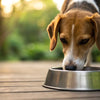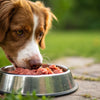Is Raw Dog Food Bad for Dogs? Understanding the Risks and Benefits
- Houndsy
Table of Contents
- Introduction
- The Rise of Raw Dog Food
- The Risks of Raw Dog Food
- The Potential Benefits of Raw Dog Food
- Expert Opinions on Raw Diets
- Making the Right Choice for Your Dog
- Conclusion
- FAQs
Introduction
As mindful pet owners, we strive to provide our furry companions with the best possible nutrition. A growing trend among dog lovers is the raw food diet, which advocates for meals made up of uncooked meat, bones, fruits, and vegetables. This dietary practice is often hailed for its potential benefits, such as shinier coats and improved energy levels. However, there are significant concerns regarding the safety and nutritional adequacy of raw dog food diets.
Did you know that the Centers for Disease Control and Prevention (CDC) estimates that around 1.2 million cases of foodborne salmonellosis occur annually in the United States? Many of these pathogens can also affect our pets, making the discussion about raw dog food diets more urgent than ever. In this blog post, we will explore the nuances of feeding raw dog food, investigating whether it is beneficial or potentially harmful to our beloved pets. By understanding these aspects, you can make a more informed decision about what’s best for your dog’s nutrition.
We will cover essential topics, including the historical context of raw dog diets, nutritional requirements for dogs, inherent risks, benefits, and expert insights on how to safely navigate this controversial feeding practice. By the end of this post, we hope that you will have a better grasp of the question: "Is raw dog food bad for dogs?" and how it aligns with our commitment to pet well-being at Houndsy.
The Rise of Raw Dog Food
The concept of raw dog food isn't novel. Its popularity surged in the early 1990s, largely propelled by Australian veterinarian Ian Billinghurst, who introduced the BARF diet—Bones and Raw Food. Billinghurst believed that dogs would thrive on a diet reminiscent of their evolutionary ancestors, which consisted of unprocessed, natural foods. While racing greyhounds and sled dogs were typically fed raw diets, opening this feeding practice to household pets sparked a sea of debate.
Historical Context
The BARF diet proposes that feeding dogs raw meat and bones mimics their natural eating habits before domestication. However, it raised eyebrows and concerns amongst veterinarians, who argue that such a diet might offer more risks than benefits. Despite the growing popularity of raw feeding, various studies suggest that many dog owners are underinformed about the associated risks and nutritional needs of their pets.
Nutritional Requirements for Dogs
Regardless of the debate surrounding raw diets, it's important to recognize that dogs require a balanced diet that includes protein, fats, carbohydrates, vitamins, and minerals. Dogs are considered omnivores, which means they can thrive on a variety of food sources, from meats to grains and vegetables.
The challenge with raw dog food diets is ensuring they meet these nutritional requirements. Many commercially available raw food products lack a nutritional adequacy statement, raising concerns over potential deficiencies. In contrast, high-quality kibble, like what we offer at Houndsy, ensures a balanced nutrient profile tailored to your dog’s needs.
The Risks of Raw Dog Food
While raw diets can potentially benefit some dogs, they also come with significant risks that every pet owner should be aware of. The primary concerns around raw dog food include:
Bacterial Contamination
A major risk associated with raw dog diets is the potential for bacterial contamination. Studies conducted by the CDC and the FDA reveal that various raw pet food products often harbor harmful bacteria, including Salmonella and Listeria monocytogenes. According to the FDA, raw pet food was significantly more likely to contain disease-causing bacteria than other types tested.
-
Pathogens: These bacteria pose serious health risks for both dogs and their owners. Dogs can carry these bacteria in their intestines without exhibiting any signs of illness, turning them into reservoirs of disease within households.
-
Human Health Risks: The transmission of bacteria can result in foodborne illnesses among humans as well. Symptoms of salmonellosis include fever, vomiting, and diarrhea, while listeriosis can lead to more severe complications, especially for individuals with weakened immune systems.
Nutritional Deficiencies
Another critical concern regarding raw feeding is the potential for an unbalanced diet. While raw diets may provide adequate protein, they often fall short in other essential nutrients:
-
Micronutrient Gaps: Key vitamins and minerals might be lacking, leading to serious long-term health issues for your dog. For instance, excessive protein without sufficient calcium can damage bone health.
-
Homemade Raw Diet Risks: Homemade raw diets are particularly prone to being nutritionally deficient unless formulated by a qualified veterinarian or pet nutritionist. If you’re considering a raw diet for your dog, it's prudent to consult with a vet to ensure dietary balance.
Choking Hazards and Digestive Issues
Feeding dogs whole or large bone fragments can also present severe risks. Sharp fragments can puncture the gastrointestinal tract, leading to dangerous complications. Furthermore, some dogs may experience gastrointestinal upset when transitioning to raw diets due to the change in protein sources or increased fat content.
The Potential Benefits of Raw Dog Food
Despite the risks, proponents of raw dog foods often cite several potential benefits:
Healthier Skin and Coat
A common claim is that raw diets can promote healthier skin and a shinier coat, attributed to the increased fat content in raw foods. Additionally, the lack of preservatives and the nutrient density found in raw ingredients may contribute to these observed improvements.
Improved Dental Health
Chewing on raw bones is believed to help clean dogs' teeth, potentially reducing the risk of dental plaque and bad breath. However, caution should be exercised when introducing bones to avoid choking or dental injuries.
Increased Energy
Some pet owners report increases in their dog's energy levels and vitality as a result of shifting to a raw diet. It's important to note, though, that the apparent increase in energy may stem from the higher protein content rather than the raw diet itself.
Expert Opinions on Raw Diets
Veterinary professionals generally advise caution when considering raw dog food diets. While they acknowledge that some dogs may thrive on raw nutrition, the associated risks necessitate consultation with a veterinarian. It's crucial for pet owners to fully understand the implications of feeding their pets raw food.
Recommendations for Safe Handling
If you are determined to offer your dog a raw diet, you can take several precautions to minimize the risks:
- Wash Hands and Surfaces: Always wash hands and disinfect surfaces that come in contact with raw dog food.
- Store Properly: Freeze raw meat and avoid thawing it on countertops; use the refrigerator instead.
- Consult Your Veterinarian: Always have your veterinarian involved in dietary decisions, especially when considering homemade raw diets.
Making the Right Choice for Your Dog
At Houndsy, our commitment to quality and pet well-being is paramount. We understand the challenges of choosing the right diet for your dog, and we believe that feeding decisions should be based on sound information and professional guidance.
Where to Start
Here's how you can ensure your dog receives optimal nutrition:
-
Evaluate Your Dog’s Health Needs: Each dog is unique, and dietary requirements may vary based on age, breed, medical conditions, or lifestyle. Consulting with a veterinarian is essential.
-
Choose Reliable Products: Whether you decide on raw, fresh, or traditional dog foods, prioritize products that demonstrate quality and nutritional adequacy. At Houndsy, our Kibble Dispenser makes it easy to store dry dog food safely and conveniently, enhancing your feeding routine while ensuring you provide quality nutrition.
-
Monitor Your Dog: Regularly observe your pet’s health, coat condition, and energy levels. Any significant changes should trigger a review of their diet.
Conclusion
The question of whether raw dog food is bad for dogs is complex, as both the benefits and risks contribute to a nuanced discussion. While some dogs may thrive on raw diets, the overarching consensus among veterinary professionals is caution due to the potential dangers associated with bacterial contamination and nutritional deficiencies.
Ultimately, the decision on what to feed your pet must be informed and guided by professional advice. As pet parents, we all want the very best for our companions. At Houndsy, we strive to elevate the pet feeding experience through our innovative Kibble Dispenser, designed to simplify and enhance how we nourish our beloved dogs.
Are you ready to transform your pet's feeding routine? Check out our Houndsy Kibble Dispenser here and experience a hassle-free way to provide your dog with the nutrition they need!
FAQs
Is raw dog food safe for all dogs?
Not all dogs are suitable candidates for a raw diet. Dogs with immunocompromised conditions, digestive issues, or puppies may be more vulnerable to the associated risks of raw feeding.
What are the risks of bacterial contamination in raw dog food?
Raw dog food can harbor harmful bacteria such as Salmonella and Listeria, posing health risks to both dogs and humans. Proper handling and hygiene practices are essential to minimize these risks.
Can I make my own raw dog food at home?
While some pet owners successfully prepare homemade raw diets, it's critical to ensure they are balanced and meet all nutritional needs. Consulting with a veterinary nutritionist is highly recommended.
How can I safely transition my dog to a raw diet?
If you decide to transition your dog to a raw diet, do it gradually to help avoid digestive upset. Monitor their health closely and consult your veterinarian for guidance.
What are the best alternatives to raw dog food?
High-quality commercial dog foods that are AAFCO-approved are generally safe and nutritionally complete. Fresh food, minimally processed, could also be a balanced option with fewer risks compared to raw feeding.












